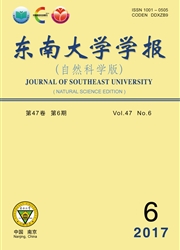

 中文摘要:
中文摘要:
声子在纳米尺度下的输运需要考虑量子效应与边界效应,通过解析方法获得其传输特性比较困难,采用蒙特卡洛方法(Monte Carlo,MC)构建了声子在体态硅与硅纳米线结构中的输运模型,简化了边界散射的选择机制与处理方法.在15-1 000K的温度范围内,对体态硅的热导率进行了模拟,验证了MC模型对本征散射处理方法的正确性,进而模拟了等效直径为22,37与56nm的硅纳米线在15-315K温度范围内的热导率,37和56nm硅纳米线热导率与实验值符合较好,22nm硅纳米线热导率比实验值偏大.分析认为随着等效半径的减小,声子色散曲线发生改变,迟豫时间减小,声子发生边界散射的频率增加,导致热阻增大.基于以上分析,通过对边界散射迟豫时间的修正,获得了与实验值较为一致的模拟结果.
 英文摘要:
英文摘要:
Due to the quantum and boundary effects, it is hard to obtain the properties of phonon transport in a low dimensional structure by means of analytical solutions. A dedicated Monte Carlo model was built by simplifying the phonon scattering processes to study the thermal properties for bulk silicon and silicon nanowire. Phonon transport in bulk silicon was simulated at temperature ranging from 15 to 1 000 K,which proves the correctness of the MC model. Furthermore, the silicon nanowires with equivalent diameter of 22,37 and 56 nm over a temperature of 15 -315 K were simulated. Though the results for 37 and 56 nm nanowires agree well with experimental data, the 22 nm one deviates significantly. The results indicate that with the decrease of diameter of nanowire, the phonon disperse relations deviate from that for bulk material greatly, which leads to the reduction of boundary relaxation time and increase of the frequency of boundary scattering. By modifying the relaxation time scale, reasonable simulation results are obtained in our model.
 同期刊论文项目
同期刊论文项目
 同项目期刊论文
同项目期刊论文
 期刊信息
期刊信息
